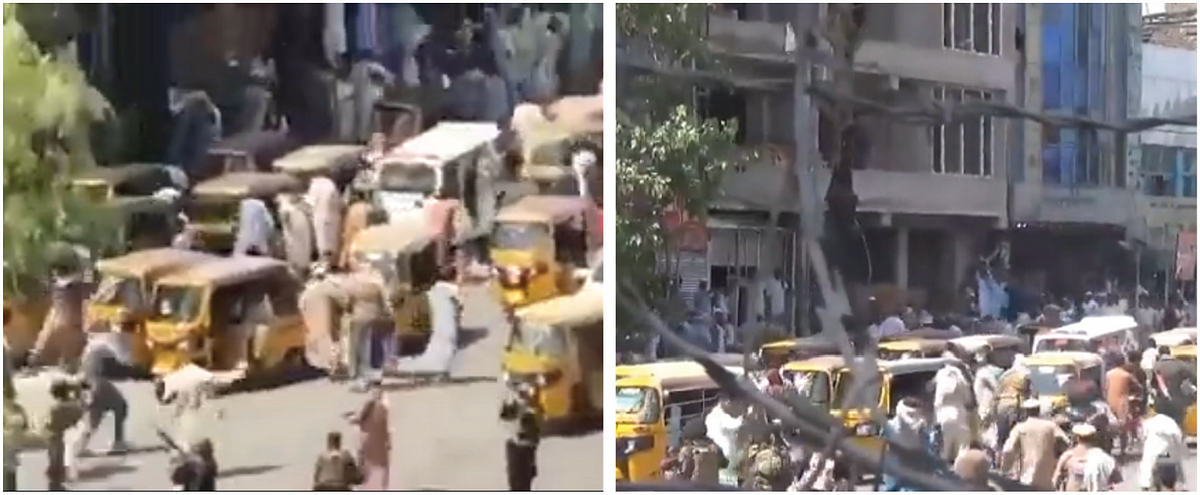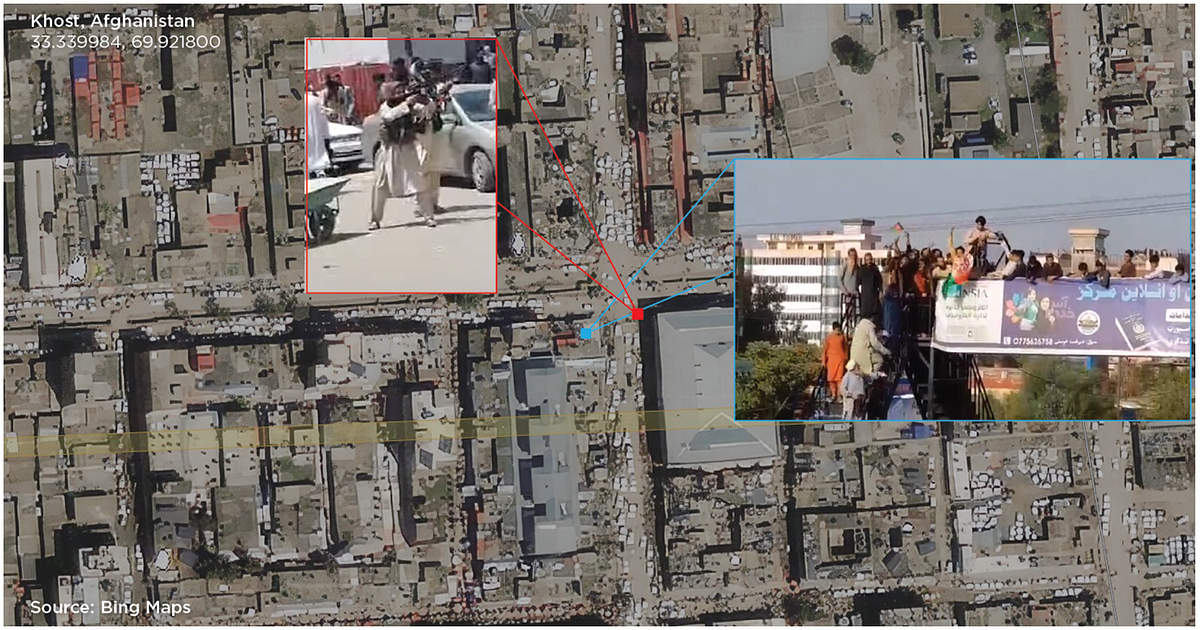Taliban fighters used gunfire to dispel crowds of Afghans marching with the national flag in multiple provinces in the east of the country

By Ayushman Kaul
The Taliban, despite its declarations to the contrary, appears to be resorting to its old tactics of exerting control over the population by intimidation and threat of force, as the DFRLab confirmed three incidents involving the group’s fighters in the cities of Jalalabad, Khost, and Mar-Koh’ in eastern Afghanistan.
Since launching its heightened offensive following US President Biden’s announcement of the withdrawal of US troops from the country, Taliban officials have made public statements claiming that the group would not resume the oppressive practices enforced under the previous Taliban government in the late 1990s. The Taliban claimed it would instead adopt a more conciliatory approach offering Afghans some social and legal protections, but only under the framework of Sharia law.
This supposed new approach, however, has not been reflected on the ground. Evidence has begun to surface of systematic violence against those under Taliban control — for example, the torture and killing of ethnic Hazara men in Ghazni province documented by Amnesty International and Radio Liberty reportage on the execution of Abdullah Atefi, an Afghan poet and historian, by Taliban fighters on August 4 in Uruzgan Province. These actions matched with an intent to control information flow by restricting mobile phone services and aggressive policing of the contents of residents’ phones.
The disconnect between the Taliban’s official public messages and actions is not surprising given the group’s inclusion of extremists and extreme ideology and need for international recognition. However, three operational factors are at play. As the Taliban seeks to transition from insurgency to national government, it faces a changed, hyperconnected environment in which it is harder to control information about events around the country. While the Taliban’s communications and propaganda structure is relatively centralized, its military command structure is decentralized and grants operational initiative to local commanders. Over time, this will make it harder for the Taliban to govern in a consistent manner and to maintain a unified propaganda strategy.
In the face of Taliban’s attempts to control information in Afghanistan, the DFRLab has gathered — and expects to gather more — open-source evidence of gunfire being used to intimidate protesters in multiple locations in Afghanistan. It is likely that more graphic evidence of the Taliban’s crackdown will continue to emerge.
Claiming a new veneer of legitimacy, hiding the violence within
Days after conquering Kabul following a week’s long blitzkrieg offensive that saw Taliban fighters capture 27 of the country’s 34 provinces in rapid succession, Zabihullah Mujahid, the official spokesperson for the insurgent group, called a press conference in the Afghan Presidential Palace to outline the shape and direction of the new Taliban regime.
While refusing to give specific details regarding the personnel and structure of the new Taliban government and claiming that “serious talks” with various stakeholders were underway, the spokesperson announced that all employees and security personnel affiliated with the former government would be given amnesty. He also declared that Afghan women would be offered some freedoms “within the bounds of Islamic law.” Under the previous Taliban regime and in areas controlled by Taliban since, however, women and girls have been subjected to consistent human rights abuses central to the Taliban’s ideology.
Such statements form part of a strategy employed by the Taliban seemingly aimed at cultivating broader international recognition and legitimacy but belie the reported violence undertaken the broader ranks of the Taliban at local levels.
Widening gulf between theory and practice
Despite such assurances, many local journalists remain skeptical of the groups supposed new merciful approach, instead pointing toward multiple credible reports of atrocities carried out by fighters in the territory captured by the group since the start of the full withdrawal of Western militaries on May 1, 2021. The growing incidence of such events in turn signals a widening gulf between the public pronouncements made by Taliban officials and the practices implemented by their fighters on the ground.
On July 14, Radio Liberty revealed the Taliban had resumed implementing many of the repressive laws that characterized their prior rule in the northeastern and northwestern districts of Faryab, Jawzjan, and Badakhshan that had been recently captured by the group. On August 5, the same outlet reported that the militant group had curbed local press freedom by forcibly closing local radio stations, newspapers, and broadcasters in the districts under their control and directing others to broadcast only pro-Taliban propaganda and pre-approved news bulletins.
Similarly, the Associated Press highlighted how, in July, Taliban fighters went door to door in Malistan district in Ghazni province searching for ex-government employees, eventually killing at least 27 civilians, wounding 10 others, and looting homes in the area. The Economist reported other incidents in which Taliban fighters executed dozens of government supporters in Spin Boldak in late July, as well as on the murder of a popular comedian in the southern city of Kandahar around the same time period.
New footage emerges
On August 18, less than 24 hours after the Taliban spokesperson’s assurances from the Presidential Palace in Kabul, Tolo News, a local media outlet reported crackdowns on civilians by Taliban fighters in various cities across the east of the country including the provinces of Nangarhar, Kunar, and Khost.
In these provinces, Afghans marched through the streets brandishing the national red, green, and black flag of the recently deposed Islamic Republic of Afghanistan in protest of the white Taliban flag. In some cases, the Taliban responded to these crowds with gunfire, killing three and injuring many more.
The DFRLab compiled a number of open-source videos that hint at violent intimidation through gunfire or direct use of force, though none of them showed the outcome of such actions. Often, the Taliban can be seen in the videos firing guns into the air as a means of dispersing crowds. In one instance, a Taliban fighter is seen shooting toward a pedestrian walkway over a main thoroughfare in Khost, but the walkway appeared to be sparsely crowded at the time. In a separate instance, a member of the Taliban can be seen charging at somebody with a stick raised high, but the video cuts away before a blow is struck.

The footage of these events emerged on Twitter and YouTube after being uploaded by multiple accounts belonging to local journalists, news outlets still operating in the country, and Afghan citizens.
Jalalabad
In Jalalabad, the Taliban’s crackdown appeared to occur in the city center of Pashtunistan Square. One video, uploaded to YouTube channel “AFG TU-M” run by a local journalist, depicted a large crowd with Afghan national flags marching down the main road and arriving at the square.

In another video, uploaded to YouTube channel “BabaMeenaKabul” dedicated to a neighborhood in eastern Kabul, a crowd can be seen waving the Afghan national flag on the square while vehicles with white flags pull up. Armed men dismount from the vehicles and begin yelling at and shoving members of the crowd. In a separate shot from the same location, people can be seen fleeing the same location accompanied by the sound of gunfire.

Other footage taken of the same location reveals the full extent of the chaos. Two other videos revealed a group of men firing indiscriminately from the same location where armed men had earlier disembarked their vehicles and shoved members of the crowd.

In the above images, the armed men can be seen firing into the air at the bottom of the frame, before charging at the fleeing crowd. Just down the street, however, appeared to be a different story.

Other footage, uploaded on YouTube by “Adilkhan Shinwary official,” showed a large crowd waving Afghan national flags and jeering at passing Taliban trucks at an intersection about 250 meters east of Pashtunistan Square. Taliban fighters in pickup trucks circled the area but did not engage with the crowd. One dismounted group of armed men appeared to have been cornered by the crowd at the center of the intersection. Protesters were also able to fly the Afghan national flag in other parts of Jalalabad, seemingly without reprisal.
Mar-koh’
The Taliban resorted to similar tactics to dispel another protest march in Mar-koh’, a small town about 40 kilometers south-east of Jalalabad. In a video shot from a building still undergoing construction, a large crowd waving Afghan national flags could be seen at the market that makes up the town’s main road.

Geolocation of this town was initially difficult due to outdated satellite imagery and the fact that all available footage of the incident was labelled as “Jalalabad.” The outline of the mountain in the background, however, allowed for the identification of the location.

In the video, a group of armed men approach the peaceful protesters, some even appearing to be carrying Afghan national flags themselves. Eventually they attempt to disperse the crowd, but quickly resort to violence. Just before the camera pans away, one of the men can be seen running at the crowd with a stick while gunfire rings out in the background.
Khost
In Khost, a crowd gathered in the city center waving the national flag, many of them concentrated on a newly erected footbridge. Taliban fighters soon arrived at the scene and, as seen in footage recorded in other cities across the east, quickly resorted to gunfire to disperse the protesters.

In one video, uploaded onto YouTube channel “Abdul azim Badakhshi official,” which is dedicated to an Afghan mixed martial arts fighter, one man is visible aiming and firing his M-16 directly at the protesters on the footbridge while other gunshots ring out. This Taliban fighter repeatedly fired directly at the footbridge in at least two separate instances. At one point, bystanders appeared to attempt to interrupt his gunfire, but he resumed shortly after. Later in the video, a young man can be seen crossing the street while waving the national flag before being mobbed by armed Taliban.

Conclusion
While the passage of time will ultimately reveal how authentic the Taliban’s claims of adopting a softer approach in the new regime are, media reports and video footage emerging from the country provide a bleak prognosis for Afghans forced to live under Taliban rule.
In the footage of all three incidents examined by the DFRLab, Afghan citizens engaging in peaceful demonstrations under the Afghan national flag were violently dispersed by Taliban fighters, indicating that, despite the group’s public claims to the contrary, their old form of governance premised on the threat and exercise of violence against ordinary citizens appears unchanged.
The DFRLab will continue to monitor the ongoing situation in Afghanistan.
Ayushman Kaul is a Research Assistant, South Asia, with the Digital Forensic Research Lab.
Cite this case study:
Ayushman Kaul, “Multiple videos surface of Taliban fighters using gunfire to disperse crowds,” Digital Forensic Research Lab (DFRLab), August 20, 2021, https://medium.com/dfrlab/multiple-videos-surface-of-taliban-fighters-using-gunfire-to-disperse-crowds-2a630d3dcae0.
Follow along on Twitter for more in-depth analysis from our #DigitalSherlocks.

